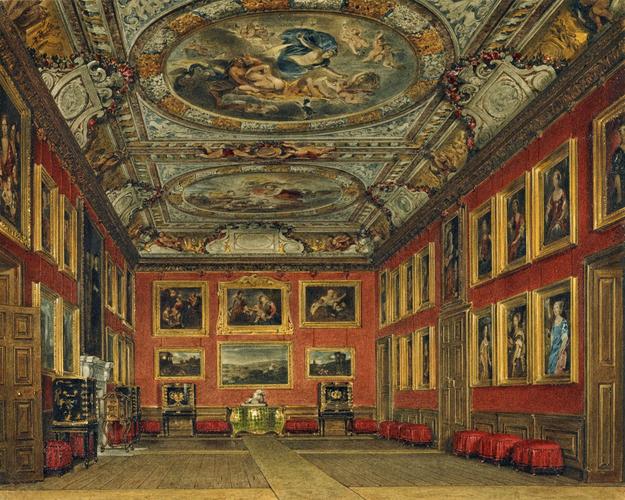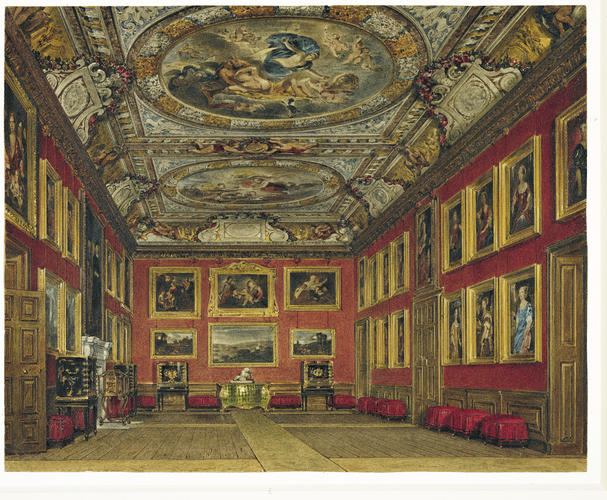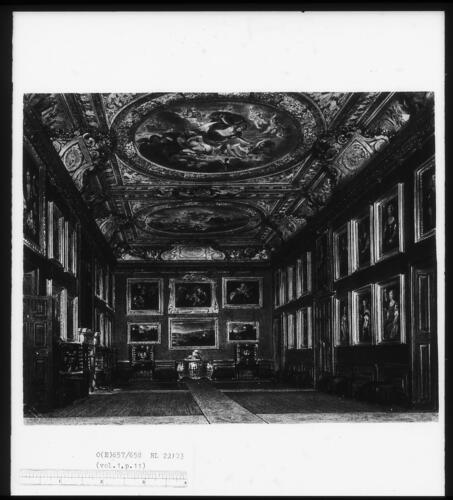-
1 of 253523 objects
Windsor Castle: The Queen’s State Bedchamber c. 1818
Pencil and watercolour with touches of bodycolour | 20.2 x 25.4 cm (sheet of paper) | RCIN 922103

James Stephanoff (1789-1874)
Windsor Castle: The Queen’s State Bedchamber c. 1818

James Stephanoff (1789-1874)
Windsor Castle: The Queen’s State Bedchamber c. 1818

James Stephanoff (1789-1874)
Windsor Castle: The Queen’s State Bedchamber c. 1818



-
A watercolour depicting The Queen's State Bedchamber, a large room with red walls and a ceiling by Verrio of 'Diana and Endymion'. Prepared for one of the plates in William Henry Pyne's 'History of the Royal Residences' (1816-1819). Engraved by J. Baily, the print published 1.4.1818.
Pyne's 'History of the Royal Residences' was a three-volume publication which encompassed a number of royal residences, including Windsor Castle (vol. 1) and Buckingham House (vol. 2), presenting 100 hand-coloured engravings of exteriors and interiors accompanied by descriptive texts. The 100 watercolours which were engraved for the publication survive in the Royal Library; these watercolours are exactly the size of the image on the printed plates, and may perhaps have been intended as colour guides for the artists responsible for hand-painting the monochrome prints.
The State Bedchamber lay immediately to the west of the Drawing Room; apart from small closet rooms to the west (accessible through the central door in the right wall), it was the last room in the Queen’s Apartments. It is unlikely that Queen Charlotte ever slept in this room: her private apartments were on the east front of the castle. However, in 1778 a magnificent new canopied bed was delivered for her State Bedchamber at Windsor, decorated with fine floral needlework. The bed, and the two armchairs and ten stools supplied at the same time, remain in the Collection.
The room as shown in this view was created by James Wyatt as part of his work in the State Apartments in the early years of the nineteenth century. Before 1804 the space was occupied by the Bedchamber to the north and by an ante room and service staircase to the south. To complete the decoration, Verrio’s ceiling, depicting Diana and Endymion, was joined by a new area of ceiling, painted in a very similar style by John Rigaud - showing Jupiter presenting Diana with her bow and arrows. In the 1830s the room was substantially changed when the Royal Library was transferred to this room and the rooms to the west. As part of these changes a new plasterwork ceiling was introduced and the marble chimneypiece was moved to the Queen’s Ballroom.
Queen Charlotte’s embroidered bed and suite of seat furniture were removed at the time of Wyatt’s changes. Among the contents of the room recorded for Pyne is a painted chest-of-drawers, almost certainly acquired by Queen Charlotte.
The paintings can be identified from left to right: over the door on the left margin is Licinio’s Family Group (402586). The overmantle on the left wall is Wright’s portrait of John Lacy (402803), surrounded by eight paintings in two blocks of 4; the upper tier is made up of a Ricci's Continence of Scipio (404981), a Venetian Cupid and Psyche (402783) and two Balestra mythologies (404979-80); the lower tier contains four caprice views by Carlevarijs (405314-7). The wall facing us has Titian’s Madonna and Saints (406070, upper centre), flanked by a Raphaelesque Holy Family (402725, left) and Cignani’s Charity (402784, right); these three hang over Steeter’s Boscobel Wood (404761), flanked by Helmbrecker’s two views of the Campo Vaccino (405563-4). The right wall includes 12 of the ‘Windsor Beauties’ by Lely and Wissing (in two blocks of six from 401211-2, 402573, 402575, 402580, 404514-5 & 404957-62); Lely’s portrait of Lady Byron is over the door in the centre (404089). The remaining overdoors (two at the back of the room and one top right) cannot be identified.Provenance
Probably acquired by George IV
-
Creator(s)
Acquirer(s)
-
Medium and techniques
Pencil and watercolour with touches of bodycolour
Measurements
20.2 x 25.4 cm (sheet of paper)
Other number(s)
RL 22103Alternative title(s)
The Queen's State Bedchamber, Windsor Castle.